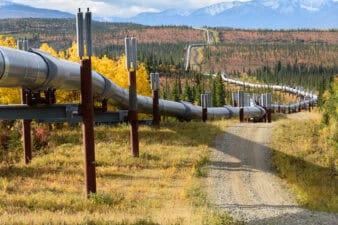Unfortunately for Canadian Oil Sands Ltd. (TSX:COS), what seemed like a potential recovery in oil prices during Q2 2015 turned out to be false—since the end of June, WTI prices have collapsed a full 22% to US$48 per barrel and significantly below the US$58 averaged in Q2.
For Canadian Oil Sands—and especially for its dividend—this is undoubtedly bad news. In January 2015 Canadian Oil Sands cut its divided by 85% from $0.35 quarterly to $0.05 quarterly, resulting in its lowest declared dividend ever. Whether or not this small dividend is sustainable depends entirely on the price of oil because Canadian Oil Sands’s cash flows are highly sensitive to oil prices.
Unfortunately, it appears that based on both current and projected oil prices for 2015, Canadian Oil Sands will face a cash shortfall and might not be able to cover its dividend, making a cut seem highly likely unless prices improve dramatically.
Why Canadian Oil Sands’s dividend looks unsustainable
According to Canadian Oil Sands most recent guidance, the company is expecting average WTI prices of $55 per barrel for 2015. The same guidance states that these oil prices would lead to cash flows of $407 million for the year. The problem is, when the company’s estimated $429 million in capital expenditures is subtracted from the company’s cash flows, there is a $22 million shortfall.
The company’s current dividend costs about $100 million annually, and subtracting that leads to a total shortfall of $122 million for 2015 at $55 dollars per barrel—an unsustainable amount. The issue now, however, is that it seems more and more likely that oil prices will average even lower than US$55 per barrel for 2015.
In Q1 2015 prices averaged $48 per barrel, and in Q2 they averaged about US$57.50, with overall prices so far averaging less than $55 dollars in 2015. The current decline below $50 again means that prices for 2015 are even more likely to come in at a lower average, which would lead to an even more significant shortfall.
The best question to ask would be, what price does oil need to be at for Canadian Oil Sands to properly maintain its dividend? With expected capital expenditures of $429 million and a dividend of $100 million, Canadian Oil Sands would need at least $529 million of cash flow to be neutral on all its expenses and not need to draw on its credit facilities.
Assuming Canadian Oil Sands produces 37.8 million barrels in 2015 (as estimated by the guidance), and the exchange rate averages at $0.82 (as also estimated by guidance), Canadian Oil Sands would need average prices of about $58 per barrel for 2015 to break even, using the company’s numbers.
Why? Since Canadian Oil Sands sells synthetic crude (which is estimated to trade at a CAD$4 per barrel discount to WTI for 2015), this would mean that Canadian Oil Sands would need to sell its synthetic crude at CAD$66.90 for 2015, which would result in the $529 million or so the company needs to break even.
Why US$58 crude is unlikely for 2015
It seems crude prices that high for 2015 are unlikely, especially considering the weak start to the year and the recent crash in prices. Analysts seem to agree. A recent report by Morgan Stanley indicated that the current oil price downturn may be as bad as the downturn in 1986 (in which the oil price took four years to recover 80% of its value from the bottom).
At this rate, oil prices could take another three to four years to recover to levels above $80 per barrel. Morgan Stanley is basing this off the idea that while demand has been rising and some projects have been shelved, OPEC production has been surging and U.S. production is near 40-year highs.








